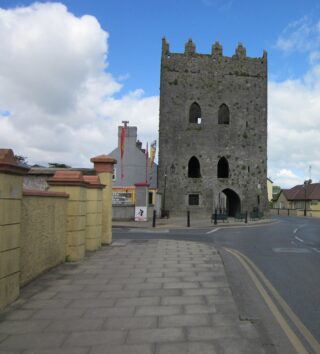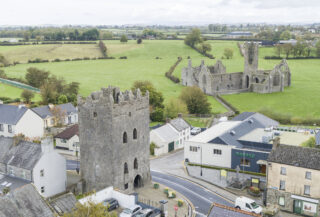Notice
King John’s Castle is a National Monument in state guardianship
*For External Viewing Only, Internal Access is Not Permitted*
WARNING: It should be noted that these sites are unguided and a level of care and caution should be maintained during all stages of your visit. The Office Of Public Works (OPW) will not be held responsible for any damages, injuries, or losses that occur
King John’s Castle
King John's Castle, a jewel in the crown of Kilmallock, is a medieval fortress, named after King John of England. However, despite its name, the Castle was likely built around the 15th century, even though King John died in 1216.
This 4-storey building boasts original mullion windows (vertical stone bars), battlements, and may have been part of the northern gate entrance to the town at the time. The pointed windows, which are a striking addition to the structure, were included in the late 18th century. It was renovated in the 19th century and used as a blacksmith’s forge for a while.
King John’s Castle is an example of a ‘Peel’ tower, which refers to a small fortified keep or tower house, and was likely not the only tower house in Kilmallock, however it is the only surviving one.
In 1645 it was used by the Irish as an arsenal under Lord Castlehaven, during the Irish Confederate Wars. However, just 6 years later, the fortress was used as a hospital in 1651 by Oliver Cromwell’s Parliamentary forces.
Today, it remains a focal point within Kilmallock (along with the Dominican Priory just across from it), with an archway on its lower level for the public to walk through, allowing people to cross through time and history.
Visit Historic Environment Viewer for more information on King John's Castle
Protect our Past - Click here to read about the importance of protecting our country’s unique heritage sites
This national monument is protected in accordance with the National Monuments Acts 1930 to 2014
Gallery
Nearby sites to visit
Lough Gur Visitor Centre and Lakeshore Park
9,000 years of life
Approx. 14.1 km from King John’s Castle
Doneraile Court and Estate
North Cork’s ‘real-life Downton Abbey’
Approx. 20.6 km from King John’s Castle
Adare Castle
Discover a medieval masterpiece, built for defence
Approx. 23.2 km from King John’s Castle
Annes Grove Gardens
A horticultural paradise in north Cork
Approx. 23.5 km from King John’s Castle
Desmond Castle Newcastlewest
Where sounds of medieval revelry echo around the walls
Approx. 33.3 km from King John’s Castle
Askeaton Castle
A ruined stronghold of the earls of Desmond
Approx. 34.8 km from King John’s Castle




